Aircraft carriers in the affairs and plans of USC
Recall that the Corporation was established in accordance with the decree of the President of Russia dated March 21, 2007 “On the Open Joint-Stock Company United Shipbuilding Corporation”. The purpose of the creation of the USC is the preservation and development of the scientific and production potential of the military-industrial complex, the provision and defense capability of state security, the concentration of intellectual, production and financial resources in the implementation of projects for the construction of ships and submarines for the naval fleetas well as the development of civil shipbuilding, the development of the continental shelf and the global maritime shipping market.
Despite its ownership, the USC is actually under the complete control of the government. All eleven members of the board of directors represent the state in one way or another, elected by a decree of the Government of the Russian Federation for a term of twelve months.
As of the beginning of 2014, the key enterprises of the corporation have developed a good financial and economic situation. By joint efforts of the state and industry, it was possible to "remove" painful moments that hindered the construction of warships for the navy. Today, the corporation’s enterprises have a high load: the main factories are loaded practically on 100% with tasks for military equipment and important civilian programs. The share of the GOZ in its load reaches 70%, less than 20% comes from military-technical cooperation, the rest is civilian products.
INS Vikramaditya
The main event of the last year was the completion of the contract on the aircraft carrier of the 11430 project. At the end of November, he went to India under his own power. In January, INS Vikramaditya completed the ocean passage with the arrival to the place of permanent location - the port of Karwar. At the present time, flight crews of MiG-29K / KUB fighters are being trained in the technology of taking off and landing from the deck of an aircraft carrier. For this purpose, a special airfield complex in the state of Goa is used, imitating the flight deck of an aircraft carrier. It is equipped with a springboard for take-off aircraft and a brake machine "Svetlana-2M".
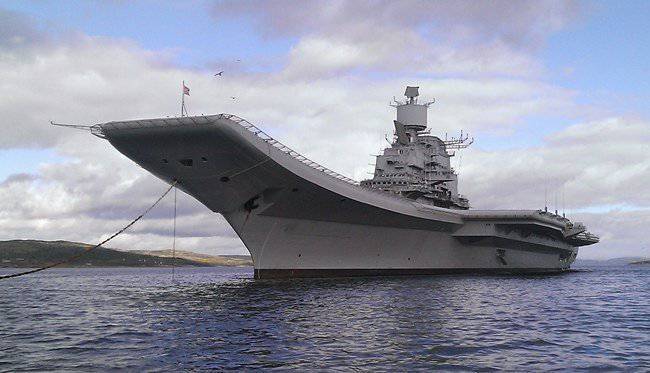
INS Vikramaditya
The ship received from Russia is compared with the INS Viraat aircraft carrier of English construction (the latter’s data are given in brackets). The standard tonnage of 34200 tons (23900), the full 45000 (28700) tons, is one and a half times higher. The maximum length of a 283,5 meter (226,5), the maximum width of a 59,6 meter (48,8). The main power plant includes eight (4) steam boilers and four (2) steam turbines with a total power of 140 (76) thousands of horsepower, reports 30 units (28) speed to the ship. The crew of the aircraft carrier, including the air wing, is 1924 man (1350). INS Vikramaditya can take on up to thirty aircraft (the same), but the main type in the person of the MiG-29K / KUB with a maximum take-off weight of 24,5 tons significantly larger Sea Harrier (11,9).
The aircraft carrier of the 11430 project represents a remake of the 1143.4 “Admiral Gorshkov” cruiser. Negotiations on the transfer of the cruiser began in the last century. At the beginning of the new side went to the stage of contracting. At that time, the domestic defense industry suffered from a chronic shortage of funds and orders. The Indian project gave Sevmash the working capital that was so necessary at that moment, which allowed the company to retain its human resources.
A thorough fault detection of a cruiser taken from the sludge showed that the amount of work required far exceeds the earlier estimates. In the course of difficult negotiations, the Russian side, who occupied whole years, managed to convince the customer to reconsider the price of the original contract, having increased it more than threefold (to 2,33 billion dollars). Fortunately, the latter was drafted in such a way that it made it possible to defend our positions in the dispute that had arisen, which helped the negotiators to reach mutually acceptable solutions.
The program also made it possible to preserve the potential of the Nevsky PKB in terms of aircraft carrier design. Under Sevmash and Nevsky PKB industrial cooperation lined up. Russia has created and has national competencies in aircraft carrier design in St. Petersburg and their construction in Severodvinsk. In terms of level, the systems installed on INS Vikramaditya are significantly different from those used on the only aircraft carrier of the Russian fleet - the Admiral Kuznetsov project of the 1143.5 project. They belong to a later generation, have a different level of technical excellence.
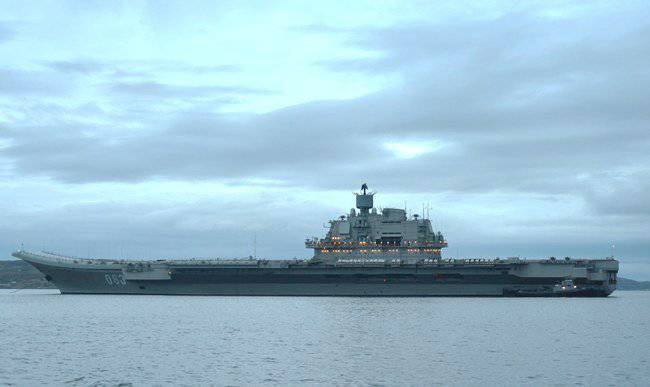
TAVK "Admiral Kuznetsov"
The implementation of the Indian deal gave impetus to the development of the aircraft’s aircraft technology. In the late eighties - early nineties, domestic aircraft designers created an outstanding aircraft for heavy aircraft carriers - the supersonic interceptor Su-33. By now it is outdated, it needs repair and modernization. With Indian money, our specialists have created a completely modern MiG-29K - a multi-purpose carrier-based fighter for solving air defense tasks, winning domination in the theater of operations and attacking naval and ground targets. These machines today are available only in the United States and France.
Next-generation aircraft carrier
In the course of carrying out a very labor-intensive repair of the Gorshkov with its restructuring from a cruiser to an aircraft carrier, Severodvinsk received specialists from other cities. Then the shift method helped, and today it no longer works. The fact is that Russia is now forming a long-term shipbuilding program for fifty years ahead. To fulfill it on time and with high efficiency, the USC should competently use all available means and resources. It is necessary to build production and cooperation so that specialists work in comfortable conditions on an ongoing basis.
The management of the corporation assures that in the foreseeable future, the number of employees in the shipbuilding industry "definitely will not decrease." Today, USC employs over 80 thousands of people. This is 10-15 thousand less than the United Aircraft Building Corporation. However, an analysis of the dynamics of changes in the number shows that continuing with the current leadership of the UAC, job cuts in the aviation industry for two to three years will lead to the fact that in terms of human resources, USC will be ahead.
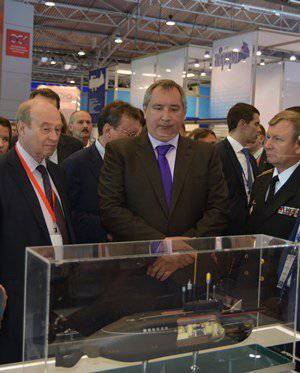
Taking into account the orders received from the USC, a promising shortage of workers is planned, an estimated ten thousand people. The personnel policy of the corporation for the coming years is based on the theses: “we value every one of our employees” and “there will be work for everyone”. As a rule, highly qualified personnel with sufficient practical experience work in domestic shipyards and design centers. Approved and implemented a program to improve the living conditions of workers by building "campuses shipbuilders" and the provision of preferential conditions for the mortgage. According to the decisions approved last year by the president of USC OJSC Vladimir Shmakov, ten thousand families of workers in Severodvinsk and St. Petersburg will receive comfortable housing.
The industrial cooperation recreated during the implementation of the “Indian project” solved the tasks of a new technology for INS Vikramaditya, while receiving economic benefits under the contract. Created backlog and competence, based on which you can create a new generation of aircraft carriers. Further movement in this area will depend on the decision of the Supreme Commander.
Former USC President Roman Trotsenko, speaking to reporters at the IMDS-2011 International Navy Show, said that the development of documentation for the next generation aircraft carrier will begin in 2016, construction will begin in 2018, transfer to the fleet is planned in 2023. However, Andrei Dyachkov, who replaced Trotsenko as president of USC (today is the general director of the Northern Center of Shipbuilding and Repair), and the current head of USC, Vladimir Shmakov, are more cautious about the prospects of aircraft carriers.
The USC has prepared and sent to various authorities proposals, the essence of which is as follows. Project work on the next generation aircraft carrier should be continued in order to preserve the accumulated design and production potential. As long as the Kuznetsov is in the ranks, Russia has the ability to support aircraft carrier wing, the corresponding skills of military personnel, aviation industry specialists and the shipbuilding industry.
We hope that the proposals of the USC will be accepted and the state will allocate funds at least to maintain the existing aviation complexes and schools for the design of aircraft carriers and aircraft for them.
"Mistral"
Perhaps the most controversial and most discussed project of the present in the field of the purchase of naval armaments for the domestic fleet is the purchase in France of amphibious-helicopter dock ships (MFDD). The contract between Rosoboronexport and DCNS for the construction of helicopter carriers was signed in June 2011.
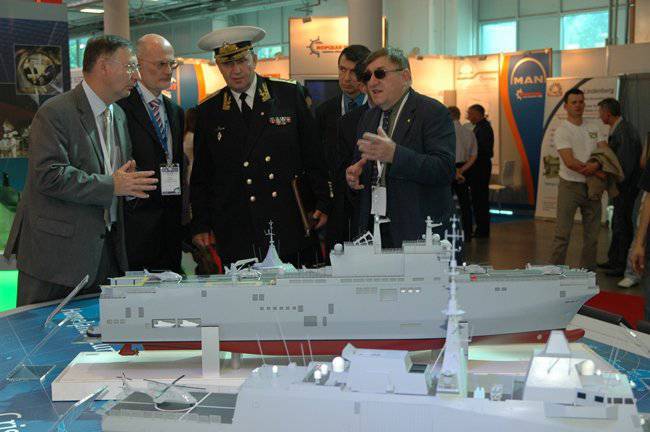
According to foreign sources, at the end of December 2010, at the level of the President of Russia, the financial terms of the acquisition of a pair of DVKD with an option for two more were approved, which imply the allocation of EUR 720 million for the first and 650 millions for the second case. According to other sources, in June 2011, the governments of Russia and France approved the agreement with a total value of 1,7 billion dollars.
Although the transaction received ambiguous public evaluation, it was approved and executed. In November, the first ship named Vladivostok will be completed with construction and will go to Russia.
The share of domestic shipbuilders in the labor intensity of construction is approximately - up to 20% on the first hull and 40% - on the second. USC had a direct contract with STX France for the construction of the aft part at the Baltic Shipyard.
Thanks to their participation in production cooperation with STX, Russian specialists gained experience of interacting with French colleagues. Perhaps the most valuable acquisition was the experience of clear planning of work stages. The parties looked at and adjusted to each other for several months. This was especially true of engineering and design departments - French designers work on different standards and schemes. The experience gained mainly related to this area.
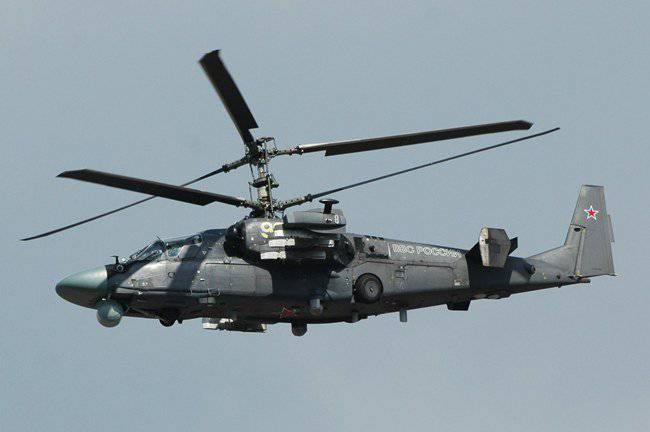
Ka-52
As regards the acquisition of something from an engineering and technological line, the benefits of the transaction turned out to be minimal. French drawings had to be redone in the walls of Russian design bureaus (in particular, by the engineering center Admiralty Shipyards), since domestic factories were accustomed to better, better completed documentation.
The quality of work performed by Russian contractors speaks for itself. When the French bow of the ship's hull was attached to the aft of the Russian ship in Saint-Nazaire, the gap was just 2mm (in fact, the weld). If funds for helicopter carriers had remained in Russia, local shipbuilders would design and build ships no worse than French ones. The large-assembly technology used in Saint-Nazaire is not new to us. It was mastered by domestic enterprises for a long time during the construction of nuclear-powered ships.
Upon arrival in Russia, the first ship of the Mistral type will not immediately take its place in the battle formation. At one of our shipyards, it will receive local-made weapons, which have yet to be integrated with the French systems. Bringing the ship to the requirements of the Russian Navy is quite a lot of work, it will take up to a year to complete. However, it will start only after the warranty period expires - in order to check the quality of work and if anything to make a claim to the supplier, Mistral should not stand at the shipyard, but walk on the seas.
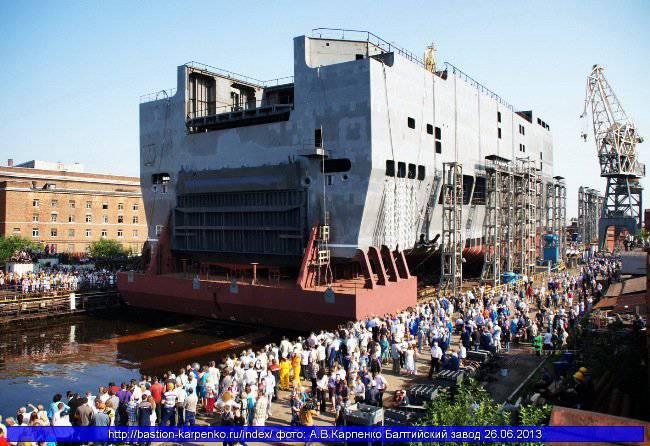
The second helicopter carrier named “Sevastopol” will be ready in November 2015. Its stern portion is already at 60% ready. In May she will be launched and in a month she will be sent to Saint-Nazaire for her to dock with the bow of French origin.
Currently, the question of what will be the first home base of Russian DVKD. As an acceptable option is called Kronstadt. Perhaps there will be work on the installation on board and the integration of Russian systems with the involvement of Sevmash specialists and other Russian plants. The alternative is Kaliningrad, but there is a limit on the width of the channels that limit the maneuvers of a large ship.
The development of the ship began in the late eighties. The L9013 Mistral head hull was built with modules at the DCNS shipyards in Brest and Alstom in Saint-Nazaire using hull structures from Poland. The assembly took place in Brest starting in 2004, adopted in the French Navy in February 2006. And in July, a helicopter carrier took part in an operation to evacuate French citizens from Lebanon. In 2007, the construction of the L9014 Tonnerre sistership was completed - two helicopter carriers cost the republic’s budget 680 million euros. The third building was built by the STX company, and DCNS was engaged in the integration of the combat system - its cost was 420 million euros.
DVKD "Mistral" is designed to transport troops and cargo, landing and can be used as a staff. Its design was created with a wide use of standards and achievements of civil shipbuilding, in particular - Ro-Ro class vessels. This is indirectly indicated by the maximum value of the stroke speed of just the 18,8 node, which is ten knots less than that of INS Vikramaditya.
The standard displacement of 16500 tons, full 21300 tons, with dock filled - 32300 tons. A docking chamber with a length of about 58 meters and a width of 15,4 meters can accommodate four landing craft. DVKD French fleet have very modest weapons from anti-aircraft missiles short-range Simbad and 12,7-mm machine guns (reserved space for 30-mm rapid-fire guns). They installed a combat information and control system SENIT 9, which is based on the previous model developed for the aircraft carrier Charles de Gaulle. Crew - 177 man, not counting the air group.
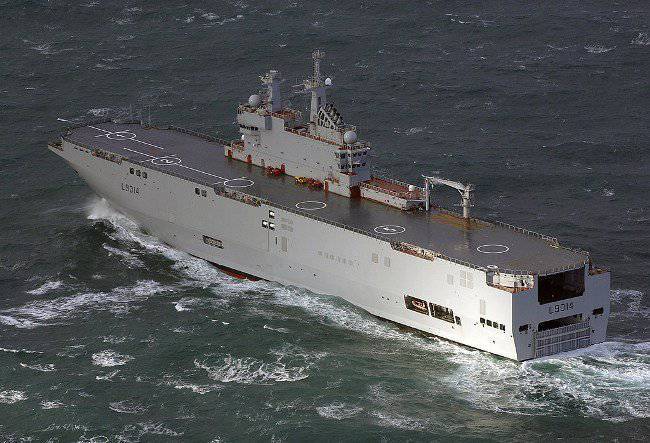
The flight deck is almost two hundred meters long and 32 wide and has an area of 6400 square meters. It has six helicopter airstrips, from which rotary-wing aircraft with a mass of up to 33 tons can operate. To support the flight operations, the radar DRBN-38A Decca Bridgemaster E250Н and the optical landing system are used. In the hangar area 1800 square meters can be located up to 16 helicopters (8 NH90 and 8 Tiger), as well as a platform for repair and maintenance. However, instead of European helicopters, our Mistrals will use domestic ones, such as the Ka-52 and Ka-29 (27 / 31). They are heavier and larger than the French, and to place in the hangar more than ten will not work.
The ship is able to provide comfortable stay for 450 paratroopers, while having on board up to 70 cars (or 40 tanks - True, in the conditions of our bases it is unlikely to actually load more than thirteen) If necessary, you can bring the number of "guests" on board to nine hundred.
The complete list of systems on the Russian Mistral is not made public. According to some sources, it will have French Thales MRR-3D-NG radar installed in G-band. Sagem will deliver an ultra-long-range Vampir NG opto-optic search and aim system. It provides passive circular panoramic observation of the surface situation, automatic detection, tracking and informing about threats of various types, from anti-ship missiles with a flat trajectory of flight over water to attacking high-speed ships.
Why do we need Mistrals and how will the fleet use them? Disputes on this topic have been going on since the first manifestation of interest to them from the then Navy Commander Vladimir Vysotsky in the 2008 year. Among the assumptions are the following: Helicopter carriers will help the transportation of cargo and personnel for military units stationed on the islands of the Kuril Ridge; They will be useful in the implementation of peacekeeping operations, as well as the designation of the presence of the Navy in such areas as the Pacific Ocean, the Black and Mediterranean Sea; It is possible to use them as training. High-boring “Mistral” with huge internal spaces is a comfortable platform for accommodating not only marines and cadets, but also civilians in case evacuation from the combat areas, natural or man-made disasters is required. It has well-equipped facilities for staff and command functions.
"Bison"
In addition to France, serious cooperation in the line of shipbuilding is conducted with Ukraine.
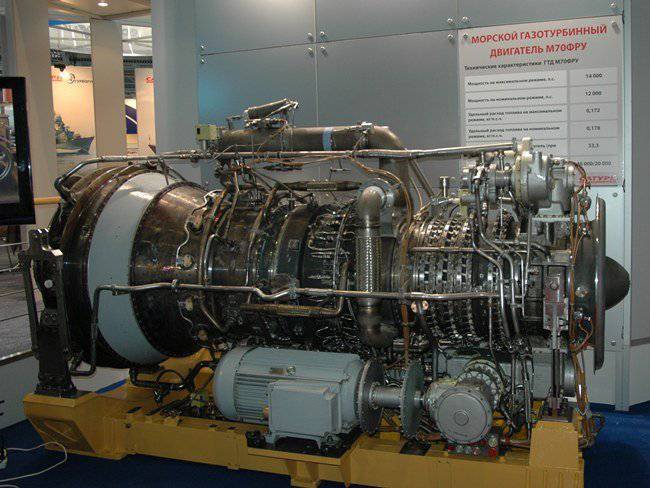
Traditionally, the main supplier of marine gas turbines to domestic warships was the South Turbine Plant. After the collapse of the USSR, the company was on the Ukrainian territory. Today it is known as “Zorya-Mashproekt” and continues to produce its main products. In cooperation with it, supplying a number of components, the Russian NPO Saturn works. This facility is known as a provider SAM146 aircraft engines for regional aircraft Sukhoi Superjet 100 and D30K family passenger airliners IL-62M and Tu-154M, cargo ramp IL-76TD / MD, and Chinese bomber H-6K (development Tu-16).
Over the past ten years, the state has released substantial funds to create a gas turbine production site in Rybinsk. The plant reached a certain capacity according to the type and class of marine gas turbines. In the future, full localization of production at the new site is possible However, this still needs to be done in terms of the quality of the gearboxes produced. The solution of the problem is possible in the next few years. However, today, USC is considering options for the practical use of Rybinsk gas turbines on serial ships. Technical issues of this application are dealt with by the OKB.
In particular, the M70FRU series 14000 HP power units developed in Rybinsk. (and still there is MHNUMXFR 90 hp) can be used by amphibious assault ships of the Bison type. Production of successful construction continues. Last year, Ukraine supplied the first Zubr from the Chinese order. According to media reports, the deal involves the supply of two Ukrainian ships, followed by localization of production.
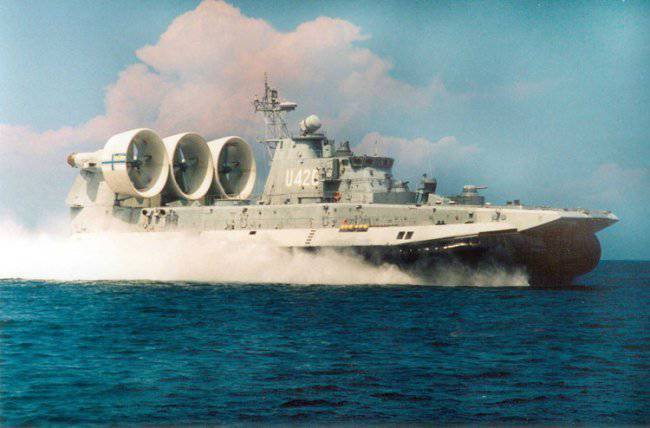
Some time ago, the Russian side tried to challenge the deal, claiming intellectual property. It remains unclear whether Rosoboronexport (engaged in marketing and selling Russian weapons abroad) in a formal manner to put forward claims and try in the courtroom to challenge the Ukrainian-Chinese agreement on "Bison"? Will the Chinese succeed in putting the bison production on stream? Is there enough documentation submitted by the Ukrainians for this? Or will the Chinese specialists have to independently release a full set? There are no answers to these questions yet.
Perspective
The implementation of long-term plans for shipbuilding will begin after the adoption of a new state armament program for the period 2016-2025. Last year, the USC Development Strategy was adopted. The document is classified as secret, only some of its provisions are known. The financial model of the corporation’s development is based on the assumption that capital expenditures for the period of 2030 will exceed one trillion rubles.
It is possible to assess the scale of the upcoming development of the domestic shipbuilding industry by comparing this figure with the financial results of the past and plans for this year. Preliminary consolidated results of the past suggest that in 2013, the revenue of enterprises that are part of USC exceeded 200 billion rubles. The 2014 revenue plan of the year is more than 350 billion. The increase is due to the introduction of especially expensive equipment. And also with an increase in labor productivity on 30-40% due to the modernization of production and an increase in the load of individual enterprises.
Information